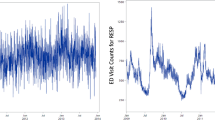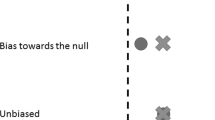Abstract
The distributed lag non-linear (DLNM) model has been frequently used in time series environmental health research. However, its functionality for assessing spatial heterogeneity is still restricted, especially in analyzing spatiotemporal data. This study proposed a solution to take a spatial function into account in the DLNM, and compared the influence with and without considering spatial heterogeneity in a case study. This research applied the DLNM to investigate non-linear lag effect up to 7 days in a case study about the spatiotemporal impact of fine particulate matter (PM2.5) on preschool children’s acute respiratory infection in 41 districts of northern Taiwan during 2005 to 2007. We applied two spatiotemporal methods to impute missing air pollutant data, and included the Markov random fields to analyze district boundary data in the DLNM. When analyzing the original data without a spatial function, the overall PM2.5 effect accumulated from all lag-specific effects had a slight variation at smaller PM2.5 measurements, but eventually decreased to relative risk significantly <1 when PM2.5 increased. While analyzing spatiotemporal imputed data without a spatial function, the overall PM2.5 effect did not decrease but increased in monotone as PM2.5 increased over 20 μg/m3. After adding a spatial function in the DLNM, spatiotemporal imputed data conducted similar results compared with the overall effect from the original data. Moreover, the spatial function showed a clear and uneven pattern in Taipei, revealing that preschool children living in 31 districts of Taipei were vulnerable to acute respiratory infection. Our findings suggest the necessity of including a spatial function in the DLNM to make a spatiotemporal analysis available and to conduct more reliable and explainable research. This study also revealed the analytical impact if spatial heterogeneity is ignored.
This is a preview of subscription content, access via your institution
Access options
Subscribe to this journal
Receive 6 print issues and online access
$259.00 per year
only $43.17 per issue
Buy this article
- Purchase on Springer Link
- Instant access to full article PDF
Prices may be subject to local taxes which are calculated during checkout






Similar content being viewed by others
References
Cromwell JB, Labys WC, Hannan MJ, Terraza M . Multivariate Tests for Time Series Models. Sage: Thousand Oaks, CA, USA. 1994.
Almon S . The distributed lag between capital appropriations and expenditures. Econometrica 1965; 33: 178–196.
Schwartz J . The distributed lag between air pollution and daily deaths. Epidemiology 2000; 11: 320–326.
Gilliland FD, Berhane K, Rappaport EB, Thomas DC, Avol E, Gauderman WJ et al. The effects of ambient air pollution on school absenteeism due to respiratory illnesses. Epidemiology 2001; 12: 43–54.
Welty LJ, Zeger SL . Are the acute effects of particulate matter on mortality in the National Morbidity, Mortality, and Air Pollution Study the result of inadequate control for weather and season? A sensitivity analysis using flexible distributed lag models. Am J Epidemiol 2005; 162: 80–88.
Braga AL, Zanobetti A, Schwartz J . The effect of weather on respiratory and cardiovascular deaths in 12 U.S. cities. Environ Health Perspect 2002; 110: 859–863.
O'Neill MS, Jerrett M, Kawachi I, Levy JI, Cohen AJ, Gouveia N et al. Workshop on Air P, Socioeconomic C. Health, wealth, and air pollution: advancing theory and methods. Environ Health Perspect 2003; 111: 1861–1870.
Yang CY, Chen YS, Chiu HF, Goggins WB . Effects of Asian dust storm events on daily stroke admissions in Taipei, Taiwan. Environ Res 2005; 99: 79–84.
Chan CC, Chuang KJ, Chen WJ, Chang WT, Lee CT, Peng CM . Increasing cardiopulmonary emergency visits by long-range transported Asian dust storms in Taiwan. Environ Res 2008; 106: 393–400.
Yu H-L, Chien L-C, Yang C-H . Asian dust storm elevates children’s respiratory health risks: a spatiotemporal analysis of children’s clinic visits across Taipei (Taiwan). PloS One 2012; 7: e41317.
Gasparrini A, Armstrong B, Kenward MG . Distributed lag non-linear models. Stat Med 2010; 29: 2224–2234.
Guo Y, Li S, Zhang Y, Armstrong B, Jaakkola JJK, Tong S et al. Extremely cold and hot temperatures increase the risk of ischaemic heart disease mortality: epidemiological evidence from China. Heart 2013; 99: 195–203.
Turner LR, Connell D, Tong S . Exposure to hot and cold temperatures and ambulance attendances in Brisbane, Australia: a time-series study BMJ Open 2012; 2: 4.
Kim YM, Park JW, Cheong HK . Estimated effect of climatic variables on the transmission of Plasmodium vivax malaria in the Republic of Korea. Environ Health Perspect 2012; 120: 1314–1319.
Chien L-C, Yu H-L . Impact of meteorological factors on the spatiotemporal patterns of dengue fever incidence. Environ Int 2014; 73: 46–56.
Szyszkowicz M, Shutt R, Kousha T, Rowe BH . Air pollution and emergency department visits for epistaxis. Clin Otolaryngol 2014; 39: 345–351.
Martinelli N, Girelli D, Cigolini D, Sandri M, Ricci G, Rocca G et al. Access rate to the emergency department for venous thromboembolism in relationship with coarse and fine particulate matter air pollution. PloS One 2012; 7: e34831.
Liu L, Breitner S, Schneider A, Cyrys J, Bruske I, Franck U et al. Size-fractioned particulate air pollution and cardiovascular emergency room visits in Beijing,China. Environ Res 2013; 121: 52–63.
Guo Y, Barnett AG, Tong S . Spatiotemporal model or time series model for assessing city-wide temperature effects on mortality? Environ Res 2013; 120: 55–62.
Xiao J, Peng J, Zhang Y, Liu T, Rutherford S, Lin H et al. How much does latitude modify temperature-mortality relationship in 13 eastern US cities? Int J Biometeorol 2015; 59: 365–372.
Wang YC, Lin YK, Chuang CY, Li MH, Chou CH, Liao CH et al. Associating emergency room visits with first and prolonged extreme temperature event in Taiwan: a population-based cohort study. Sci Total Environ 2012; 416: 97–104.
Schifano P, Leone M, De Sario M, de'Donato F, Bargagli AM, D'Ippoliti D et al.Changes in the effects of heat on mortality among the elderly from 1998-2010: results from a multicenter time series study in Italy. Environ Health 2012; 11: 58.
Zhao X, Chen F, Feng Z, Li X, Zhou XH . The temporal lagged association between meteorological factors and malaria in 30 counties in south-west China: a multilevel distributed lag non-linear analysis. Malar J 2014; 13: 57.
Little RJA, Rubin DB, Little RJA, Rubin DB . Statistical Analysis with Missing Data. John Wiley & Sons, Inc.: New York, 2002, pp 41–58.
Yu HL, Chien LC, Yang CH . Asian dust storm elevates children’s respiratory health risks: a spatiotemporal analysis of children’s clinic visits across Taipei (Taiwan). PLoS One 2012; 7: e41317.
Yu HL, Wang CH . Quantile-based Bayesian maximum entropy approach for spatiotempo- ral modeling of ambient air quality levels. Environ Sci Technol 2013; 47: 1416–1424.
Liang D, Kumar N . Time-space Kriging to address the spatiotemporal misalignment in the large datasets. Atmos Environ (1994) 2013; 72: 60–69.
Chien LC, Alamgir H, Yu HL . Spatial vulnerability of fine particulate matter relative to the prevalence of diabetes in the United States. Sci Total Environ 2015; 508: 136–144.
Kumar N, Liang D, Comellas A, Chu AD, Abrams T, Satellite-based PM . concentrations and their application to COPD in Cleveland, OH. J Expo Sci Environ Epidemiol 2013; 23: 637–646.
Department for Environment Food & Rural Affairs UK. What is the daily air quality index http://uk-air.defra.gov.uk/air-pollution/daqi?view=more-info. Accessed 30 September 2015.
Kindermann R, Snell JL . Contemporary Mathematics. Version 1. American Mathematical Society: Providence, RI. 1980.
Little RJA, Rubin DB . The analysis of social science data with missing values. Socio Meth Res 1989; 18: 292–326.
Breitner S, Wolf K, Devlin RB, Diaz-Sanchez D, Peters A, Schneider A . Short-term effects of air temperature on mortality and effect modification by air pollution in three cities of Bavaria, Germany: a time-series analysis. Sci Total Environ 2014; 485–486: 49–61.
Thiele-Eich I, Burkart K, Simmer C . Trends in water level and flooding in Dhaka, Bangladesh and their impact on mortality. Int J Environ Res Publ Health 2015; 12: 1196–1215.
Gelman A, Hill J . Analytical Methods for Social Research. Cambridge University Press: Cambridge; New York. 2007.
Henderson SB, Wan V, Kosatsky T . Differences in heat-related mortality across four ecological regions with diverse urban, rural, and remote populations in British Columbia, Canada. Health Place 2013; 23: 48–53.
Yu HL, Wang CH . Retrospective prediction of intraurban spatiotemporal distribution of PM2.5 in Taipei. Atmos Environ 2010; 44: 3053–3065.
Yu HL, Ku SC, Yang CH, Cheng TJ, Chen L Assessment of areal average air quality level over irregular areas: a case study of PM10 exposure estimation in Taipei (Taiwan). In: Advanced Air Pollution, Dr. Farhad Nejadkoorki (ed.). Available from:http://www.intechopen.com/books/advanced-air-pollution/assessment-of-areal-average-air-quality-level-over-irregular-areas-a-case-study-of-pm10-exposure-est.
Gething PW, Atkinson PM, Noor AM, Gikandi PW, Hay SI, Nixon MS . A local space-time kriging approach applied to a national outpatient malaria data set. Comput Geosci 2007; 33: 1337–1350.
Ripley BD Quadrat counts In: Spatial Statistics. John Wiley & Sons, Inc.: New York, 2005, pp 102–129.
Kulldorff M . A spatial scan statistic. Commun Stat Theory Methods 1997; 26: 1481–1496.
Acknowledgements
This study was supported by Dr Chien’s start-up funds at University of Texas School of Public Health, Dr Guo’s research fellowship at the University of Queensland, and Dr Yu’s fund from Taiwan Ministry of Science and Technology MOST 105-2221-E-002-039.
Author information
Authors and Affiliations
Corresponding author
Ethics declarations
Competing interests
The authors declare no conflict of interest.
Appendix A
Appendix A

Rights and permissions
About this article
Cite this article
Chien, LC., Guo, Y., Li, X. et al. Considering spatial heterogeneity in the distributed lag non-linear model when analyzing spatiotemporal data. J Expo Sci Environ Epidemiol 28, 13–20 (2018). https://doi.org/10.1038/jes.2016.62
Received:
Accepted:
Published:
Issue Date:
DOI: https://doi.org/10.1038/jes.2016.62
Keywords
This article is cited by
-
Acute effect of fine particulate matter and respiratory mortality in Changsha, China: a time-series analysis
BMC Pulmonary Medicine (2022)
-
Epidemiological characteristics and spatiotemporal analysis of hand-foot-mouth diseases from 2010 to 2019 in Zibo city, Shandong, China
BMC Public Health (2021)
-
Association between air pollutants and outpatient and emergency hospital visits for childhood asthma in Shenyang city of China
International Journal of Biometeorology (2020)
-
Surveillance on the endemic of Zika virus infection by meteorological factors in Colombia: a population-based spatial and temporal study
BMC Infectious Diseases (2018)



